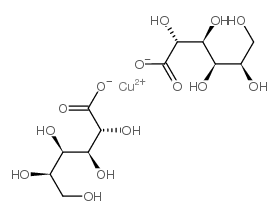13005-35-1
| Name | copper,2,3,4,5,6-pentahydroxyhexanoate |
|---|---|
| Synonyms |
EINECS 235-844-0
CUPRIC GLUCONATE Chelates of copper gluconate Cupric gluconate monohydrate copper gluconate Copper D-gluconate Copper di-D-gluconate |
| Density | 1.763g/cm3 |
|---|---|
| Boiling Point | 673.6ºC at 760mmHg |
| Melting Point | 131ºC |
| Molecular Formula | C12H22CuO14 |
| Molecular Weight | 453.84100 |
| Flash Point | 375.2ºC |
| Exact Mass | 453.03100 |
| PSA | 282.56000 |
| Appearance | Powder | blue |
| Vapour Pressure | 4.95E-21mmHg at 25°C |
|
Section 1: Product Identification Chemical Name:Copper (II) gluconate, min. 98% CAS Registry Number:13005-35-1 Formula:Cu[OOC(CHOH)4CH2OH]2 EINECS Number:none Chemical Family:salt of an organic acid Synonym:Gluconic acid, copper (+2) salt
Section 2: Composition and Information on Ingredients IngredientCAS NumberPercentACGIH (TWA)OSHA (PEL) Title Compound13005-35-1100%1mg/m3 (as Cu)1mg/m3 (as Cu) Section 3: Hazards Identification Emergency Overview:Irritating to the skin, eyes and respiratory tract. Primary Routes of Exposure:Ingestion, inhalation Eye Contact:Causes slight to mild irritation of the eyes Skin Contact:Causes slight to mild irritation of the skin. Inhalation:The material is a fine powder. Irritating to the nose, mucous membranes and respiratory tract. Ingestion:Ingestion of copper compounds may lead to vomiting, exhaustion, anemia, convulsions and coma. Acute Health Affects:Irritating to skin, eyes and respiratory tract. Chronic Health Affects:No information available on long-term chronic effects. NTP:No IARC:No OSHA:No SECTION 4: First Aid Measures Immediately flush the eyes with copious amounts of water for at least 10-15 minutes. A victim may need Eye Exposure: assistance in keeping their eye lids open. Get immediate medical attention. Wash the affected area with water. Remove contaminated clothes if necessary. Seek medical assistance if Skin Exposure: irritation persists. Remove the victim to fresh air. Closely monitor the victim for signs of respiratory problems, such as difficulty Inhalation: in breathing, coughing, wheezing, or pain. In such cases seek immediate medical assistance. Seek medical attention immediately. Keep the victim calm. Give the victim water (only if conscious). Induce Ingestion: vomiting only if directed by medical personnel. SECTION 5: Fire Fighting Measures Flash Point:no data Autoignition Temperature:none Explosion Limits:none Extinguishing Medium:carbon dioxide, foam or dry powder If this product is involved in a fire, fire fighters should be equipped with a NIOSH approved positive pressure Special Fire Fighting Procedures: self-contained breathing apparatus and full protective clothing. Hazardous Combustion andIf involved in a fire this material may emit irritating fumes. Decomposion Products: Unusual Fire or Explosion Hazards: No unusual fire or explosion hazards. SECTION 6: Accidental Release Measures Spill and Leak Procedures:Small spills can be mixed with vermiculite or sodium carbonate and swept up. SECTION 7: Handling and Storage Handling and Storage:Store in a tightly sealed container. Handle the material in a ventilated area. SECTION 8: Exposure Controls and Personal Protection Eye Protection:Always wear approved safety glasses when handling a chemical substance in the laboratory. Skin Protection:Wear protective clothing and gloves. Ventilation:Material may form a fine dust. If possible, handle the material in an efficient fume hood. If ventilation is not available a respirator should be worn. The use of respirators requires a Respirator Respirator: Protection Program to be in compliance with 29 CFR 1910.134. Ventilation:Material may form a fine dust. If possible, handle the material in an efficient fume hood. Additional Protection:No additional protection required. SECTION 9: Physical and Chemical Properties Color and Form:blue pwdr. Molecular Weight:453.85 Melting Point:no data Boiling Point:no data Vapor Pressure:not applicable Specific Gravity:1.831 Odor:none Solubility in Water:slightly soluble SECTION 10: Stability and Reactivity Stability:air and moisture stable solid Hazardous Polymerization:no hazardous polymerization Conditions to Avoid:none Incompatibility:Oxidizing agents Decomposition Products:carbon dioxide, carbon monoxide, organic fumes, and copper salts. SECTION 11: Toxicological Information RTECS Data:No specific information available on this product. Carcinogenic Effects:No data available Mutagenic Effects:No data available Tetratogenic Effects:No data available SECTION 12: Ecological Information Ecological Information:No information available SECTION 13: Disposal Considerations Disposal:Dispose of according to local, state and federal regulations. SECTION 14: Transportation Shipping Name (CFR):Non-hazardous Hazard Class (CFR):NA Additional Hazard Class (CFR):NA Packaging Group (CFR):NA UN ID Number (CFR):NA Shipping Name (IATA):Non-hazardous Hazard Class (IATA):NA Additional Hazard Class (IATA):NA Packaging Group (IATA):NA UN ID Number (IATA):NA SECTION 15: Regulatory Information TSCA:Not listed in the TSCA inventory. SARA (Title 313):See Category Code N100 for reporting. Second Ingredient:none SECTION 16 - ADDITIONAL INFORMATION N/A |
| HS Code | 2918199090 |
|---|
| HS Code | 2918199090 |
|---|---|
| Summary | 2918199090 other carboxylic acids with alcohol function but without other oxygen function, their anhydrides, halides, peroxides, peroxyacids and their derivatives。Supervision conditions:None。VAT:17.0%。Tax rebate rate:9.0%。MFN tariff:6.5%。General tariff:30.0% |
